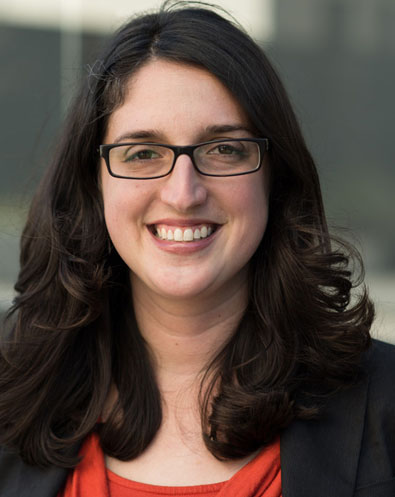
Tanya Zimbardo is a San Francisco-based curator. Her research and writing is primarily centered on conceptual art and experimental media in California in the 1970s and 1980s. She is co-curating the group survey Public Works: Artists' Interventions 1970s - Now at Mills College Art Museum this fall. As the Assistant Curator of Media Arts at the San Francisco Museum of Modern Art, she curated select film and video screenings and co-organized the past two SECA Art Award exhibitions and overview Fifty Years of Bay Area Art: The SECA Awards, among other exhibitions. She has contributed essays to several SFMOMA publications, most recently West Coast Visions(2015, Borusan Contemporary, Istanbul). As a guest contributor to Open Space (2012‒14), Zimbardo highlighted various site works, public interventions, and artist-run spaces in the Bay Area, including Receipt of Delivery, her weekly series featuring exhibition mailers.
Zimbardo joined Jasmine Moorhead in conversation at Krowswork as part of Summer of Video Art (2012). For Overture: Krowswork Residency Preview, she contributed Lowell Darling’s Last Videotape (1984), a personal favorite from Krowswork’s exhibition history, which was shot at the Video Gallery in San Francisco.
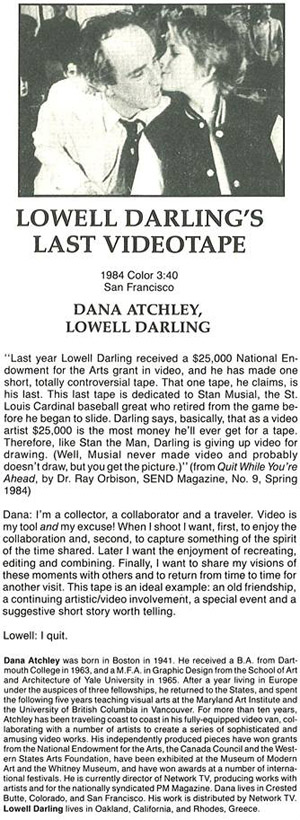
|
|
During her time at Krowswork, Zimbardo will be presenting an ongoing exhibition, Versions: Kristin Lucas and Judy Malloy, as well as a series of one-day programs, presented each Saturday of the residency.
SCHEDULE OF ONE-DAY PROGRAMS
(scroll right for more details):
Saturday, April 11, 2pm:
Conversation with Mike Henderson + screening of Down Hear
Saturday, April 18
(on view 1-5pm):
Ericka Beckman:
The Broken Rule
Howard Fried:
The Burghers of Fort Worth
Saturday, April 25
(on view 1-5pm):
Judith Barry:
Casual Shopper
Stephen Laub:
Switch
First Friday, May 1st (5-9), and Saturday, May 2nd (on view 1-5pm):
Mike Henderson: The Shape of Things
FILES—Things That Are Kept and Why: Produced by Henry S. Rosenthal |
|
VERSIONS: KRISTIN LUCAS AND JUDY MALLOY
featuring Lucas's Refresh (2007), Air on the Go (2014), and two works related to Malloy's OK Genetic Engineering (1983-85) |
|
Saturday, April 11th, 2pm
CONVERSATION WITH MIKE HENDERSON
+ SCREENING OF "DOWN HEAR" |
|
Saturday, April 18th (on view: 1-5pm):
Ericka Beckman: The Broken Rule
Howard Fried: The Burghers of Fort Worth |
|
Saturday, April 25th (on view 1-5pm)
Judith Barry: Casual Shopper
Stephen Laub: Switch
|
|
First Friday, May 1st (5-9pm) &
Saturday, May 2nd (1-5pm)
Mike Henderson: The Shape of Things +
Henry S. Rosenthal: FILES: Things Kept and Why
|
|
|
|
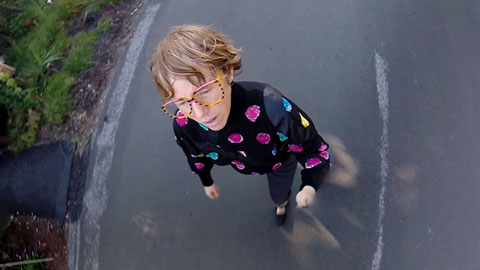
Kristin Lucas, Air on the Go, 2014; © Kristin Lucas
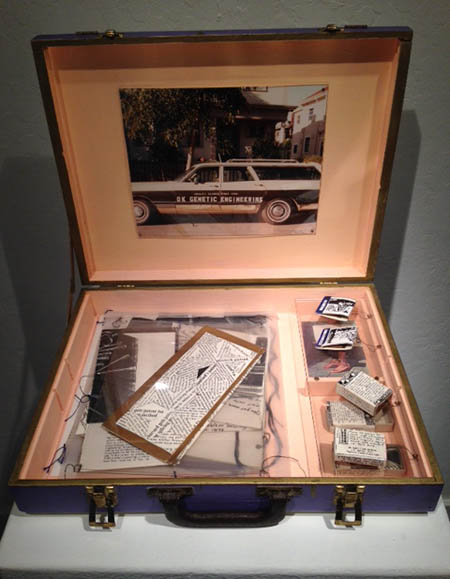
Judy Malloy, Ok Genetic Engineering, 1983-85; © Judy Malloy
Well before the recent wave of tech-driven changes and backlash in the Bay Area, Judy Malloy infiltrated the tech community in the role of president of her own R&D companies—OK Research(1980‒82), OK Genetic Engineering (1983‒85), and Bad Information(1986‒88). She solicited technical information from various industries through official letterhead, tradeshows, and visits to Silicon Valley companies. Her knowledge of how best to make an approach and to whom was facilitated by years of working as a librarian and information specialist. The Berkeley-based poet incorporated the language from the disparate materials she collected, including advertising slogans from vendors, into these artistic projects, which encompassed mail art, experimental books, performances, and installations.
As publicity for OK Genetic Engineering (OKGE) in 1983, Malloy drove her company car, a station wagon with “OK Genetic Engineering – Quality Clones since 1984” painted on the sides, and asked passersby about their attitudes toward the field. Her public interventions in the Bay Area included making handmade matchbooks with Xerox copy and leaving them on tables at restaurants, as free handouts at art events, and distribution by mail. Small reproducible combinations of words and images formed the basis of her reports dealing with various aspects of the biotechnology industry and her related products: the HLIV (Human Lust Inducing Virus), SH gene (Shrinkage Hormone Gene) and NFD bacteria (Nuclear Fuel Devouring Bacteria). The current exhibition revisits Malloy’s prescient examination of the role of technology in our society through documentation of this key information art project as represented in the OKGE Files (1986) and OKGE Briefcase (1991).
Versions pairs Malloy’s OKGE with Kristin Lucas’s Refresh (2007), another landmark public intervention in the Bay Area addressing perceptions of change and promise of technology. The artist became the most current version of herself when she succeeded in legally changing her name from Kristin Sue Lucas to Kristen Sue Lucas in a Superior Court of California courtroom in Alameda—to “refresh” herself as if she were a web page.
For Lucas, the outcome she sought was a new vantage point or intervention into her own life. This action was also analogous to putting a virus into the system, an imperceptible change that would cause a wave of legal red tape and discussions with various agencies processing the same name change. The idea of a distributed sense of self is mirrored in the iterative nature of the project, which has included participatory readings of the philosophical debate between Lucas and the presiding Judge in the courtroom transcript, and is represented in this presentation as an installation of a take-away Refresh zine (2014). Lucas performs a monologue about staying current in a data-driven climate in the multi-channel video installation, Air on the Go (2014). Her text is culled from online forums and user-generated product reviews about tools and apps designed for monitoring and tracking the human body and atmospheric conditions. The artist roams the suburbs like a moving node on a map. She used several small cameras mounted on a monopod to capture a 360-degree view, created through video stitching software, which erases the equipment she carries like a magic wand or scepter.
Both Lucas and Malloy employ found language to describe perceived shifts in the media landscape and our sense of being in the world.
|
|
Talk / Screening / Reception: 2pm (with screening continuing after talk):
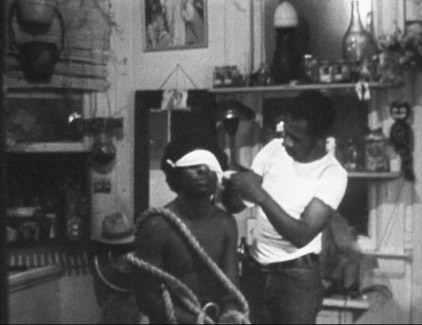
Mike Henderson, Down Hear, 1972 © Mike Henderson
Join us for an informal conversation between Mike Henderson, renowned East Bay filmmaker, painter, and blues musician, and Tanya Zimbardo, assistant curator of media arts at the San Francisco Museum of Modern Art (SFMOMA) and Krowswork's third guest resident of 2015.
The program will include a screening Henderson's 12-minute film Down Hear (1972, 16mm transferred to video, black-and-white, sound). This work powerfully contends with the story of slave ships through a charged performance by Henderson and his brother Raymond. The inspiration for the accompanying blues soundtrack came to Henderson after observing a police conflict with neighborhood kids in the projects across the street from his home in San Francisco's North Beach. Henderson notes that he made the film with an audience of African American youth in mind, offering "a possibility for living with this ambiguity that life gives us, with the courage and understanding that we all could find an outlet for our hopes and dreams . . . what makes life worth living down here."
From 1970 to the mid-1980s, Henderson made more than two dozen solo and collaborative films with artists such as Robert Nelson, Michael Rudnick, and William T. Wiley. Henderson's short experimental films have recently been the subject of a major preservation project by the Academy Film Archive in Los Angeles, led by Mark Toscano; Toscano also has curated a number of screenings of Henderson's work, including a spotlight program last year at the Exploratorium, copresented by the Exploratorium's Cinema Arts program, SF Cinematheque, Museum of the African Diaspora (MoAD), and Haines Gallery. Henderson's moving-image work has been highlighted at such venues as Indiana University at Bloomington; Cinema Project, Portland; Los Angeles Film Forum at LA MOCA; Pacific Film Archive, Berkeley; No Nothing Cinema; Canyon Cinema; San Francisco Art Institute; SFMOMA; Phoenix Art Museum; Crocker Art Museum; the Museum of Modern Art, New York; and the Ann Arbor Film Festival, among others.
Born in Marshall, Missouri, Henderson moved to California to attend the San Francisco Art Institute, the first racially integrated art school in the United States, where he received his BFA (1969) and MFA (1970). He was hired shortly thereafter to teach filmmaking at the University of California, Davis, where he currently is professor emeritus of the Fine Arts Department (he served as a professor there from 1970 to 2012). Henderson lives and works in San Leandro.
|
|
Ericka Beckman: The Broken Rule
1979, Super-8 film transferred to video, color, sound, 23 min., courtesy the artist>
Produced, directed, shot and edited by Ericka Beckman; Starring: Mike Kelley; Featuring: Jim Casebere, Matt Mullican, James Welling, Jim Isermann, Diane Buckler, Kirby Dick, Tom Radloff, David Fick
"The Broken Rule is my reaction to the American education system, where learning blocks must be acquired by the group before any individual can progress to the next level. My film pictures learning blocks as relay races conducted by male players, where the girls are scores, and the goal is to enter the working world by the end of the game. Mike Kelley, the lead player in my film, makes a ritual out of his mistakes to escape the consequences of his mistakes.”
— Ericka Beckman
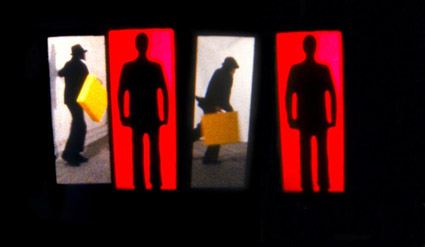
Ericka Beckman, The Broken Rule, 1979; © Ericka Beckman
Howard Fried: The Burghers of Fort Worth
The Burghers of Fort Worth, 1975‒77, 16mm film transferred to video, color, sound, 34 min., courtesy the artist
“Attempting to recreate the dynamics of art school education where one interfaces with numerous masters almost simultaneously, I took a lesson from four golf professionals at once.” — Howard Fried
Howard Fried, The Burghers of Fort Worth (production still), 1975‒77; © Howard Fried
|
|
Judith Barry: Casual Shopper
1980‒81, video, color, sound, 6 min., courtesy the artist
“Shopping is an activity that consists of predictable yet indeterminate activities where, like the cinema, what we go to experience over and over again is our own desire.” — Judith Barry
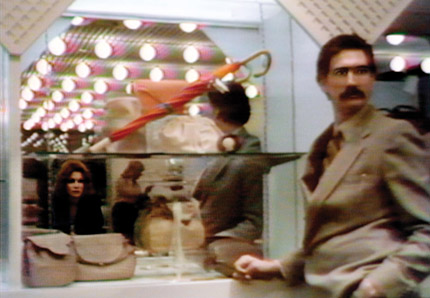 Judith Barry, Casual Shopper, 1980‒81; © Judith Barry Judith Barry, Casual Shopper, 1980‒81; © Judith Barry
Stephen Laub: Switch
Stephen Laub, Switch, 1981, video, color, sound, 3:46 min., courtesy the artist;
Voices: Susan Alexander and David Robinson
"Switch was a response to concepts in early computing. I was thinking about how its language was reduced to either 1 or 0 without anything in-between, like a switch that is either on or off. It seemed a natural extension to wonder if our responses would also evolve into 1 or 0, or "yes" or "no"." — Stephen Laub
 Stephen Laub, Switch, 1981. © Stephen Laub Stephen Laub, Switch, 1981. © Stephen Laub
|
|
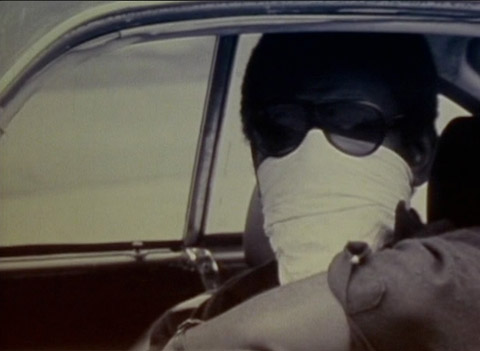
Mike Henderson, The Shape of Things, 1981; © Mike Henderson
The Shape of Things, 1981, 16mm film transferred to video, b&w and color, sound, 8 min., camera: Mike Henderson, Michael Rudnick, courtesy the artist
Henderson's The Shape of Things (1981) is a filmic meditation on artistic process, its successes and failures within and outside form. The artist nods to his various literary, musical, and cinema influences at the time in this inventive performance in the studio.
Reflecting an unusual synthesis of his music and painting backgrounds, the films span audiovisual compositional experiments, absurdist musings on creativity, and blues-driven performative pieces about Black identity, all rendered in a powerful and unadorned DIY directness.
- Mark Toscano, Academy Film Archive
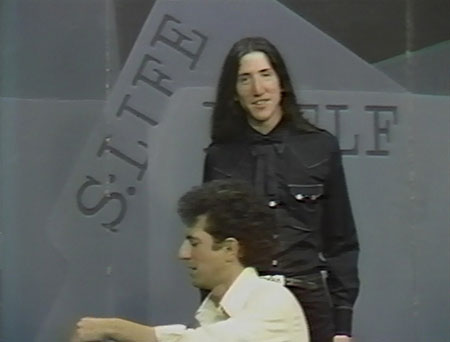
Henry S. Rosenthal, FILES: Things Kept and Why, 1976; © Henry Rosenthal
Henry S. Rosenthal: Select episodes from
FILES: Things That Are Kept And Why
Produced and hosted by Henry S. Rosenthal, the San Francisco Bay Area-based public access television series FILES: Things That Are Kept and Why (1975‒76), featured various guests from his social milieu who were invited to share stories about objects from their personal collections. The program is an interesting precedent for more recent curatorial projects that foreground the importance of artists’ archives, source materials, and collections.
This presentation at Krowswork revisits for the first time in a gallery context through three select episodes: Charles Amirkhanian, composer and then-KPFA music director, Anthony Gnazzo, composer, and Tom Marioni, artist and director of the Museum of Conceptual Art (MOCA, 1970-1984) in San Francisco.
Guest curated by Marioni, the thirteen-part series Conceptual Video Minute (1976), later compiled as A Tight 13 Minutes, appeared during the original broadcasts between the programs and commercial breaks.
FILES: Things That Are Kept and Why appeared on Viacom Cable television, first on the cable access channel and then on Channel 6, which allowed Rosenthal to sell advertising to support the show.
Executive Producer: Henry S. Rosenthal
Series Host: Henry S. Rosenthal
Director: David B. Doty
Production Coordinator: Carola B. Anderson
|
|